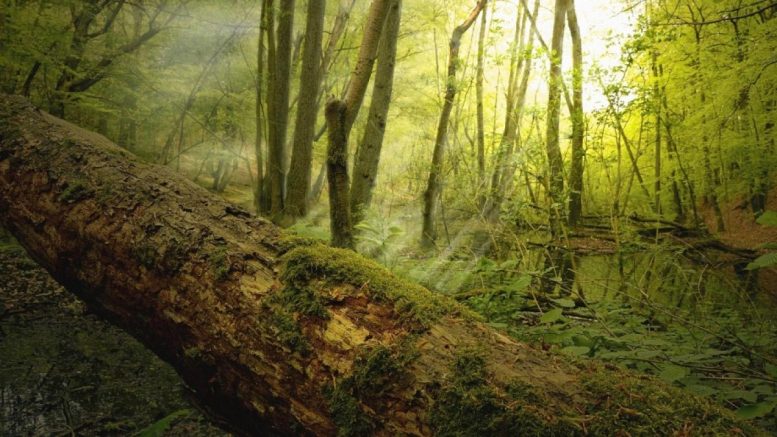
The decomposition of wood and the recycling of those nutrients is a critically important process in forests. Credit: Australian National University
Decaying wood releases around 10.9 gigatons of carbon worldwide every year, according to a new study by an international team of scientists.
This is roughly equivalent to 115 percent of fossil fuel emissions.
Co-author of the study Professor David Lindenmayer from The Australian National University (ANU) says it’s the first time researchers have been able to quantify the contribution of deadwood to the global carbon cycle.
“Until now, little has been known about the role of dead trees,” Professor Lindenmayer said.
“We know living trees play a vital role in absorbing carbon dioxide from the atmosphere. But up until now, we didn’t know what happens when those trees decompose. It turns out, it has a massive impact.”
Professor Lindenmayer said the decomposition is driven by natural processes including temperature and insects.
“The decomposition of wood and the recycling of those nutrients is a critically important process in forests,” he said.
The research showed decomposition can’t happen without wood-boring insects such as Longicorn Beetles.
“We knew insects such as termites and wood-boring Longicorn beetles can accelerate deadwood decomposition,” study co-author Dr. Marisa Stone from Griffith University said.
“But until now, we didn’t know how much they contribute to deadwood carbon release globally.
“Insects accounted for 29% of deadwood carbon release each year. However, their role was disproportionately greater within the tropics and had little effect in regions of low temperatures.”
The global research project encompassed 55 forest areas on six continents. The research team studied wood from more than 140 tree species to determine the influence of climate on the rate of decomposition.
“Half the wood was placed in mesh cages which kept out insects, allowing us to study their contribution,” Professor Lindenmayer said.
“We found both the rate of decomposition and the contribution of insects are highly dependent on the climate, and will increase as temperatures rise. Higher levels of precipitation accelerate the decomposition in warmer regions and slow it down in lower temperature regions.”
Tropical forests contribute 93 percent of all carbon released by deadwood, due to their high wood mass and rapid rates of decomposition.
The study was led by Dr. Sebastian Seibold from the Technical University of Munich.
“At a time of global change, we can see some dramatic declines in biodiversity and changes in climate,” Dr. Seibold said.
“This study has demonstrated that both climate change and the loss of insects have the potential to alter the decomposition of wood, and therefore, carbon and nutrient cycles worldwide.”
The study has been published in Nature.
Reference: “The contribution of insects to global forest deadwood decomposition” by Sebastian Seibold, Werner Rammer, Torsten Hothorn, Rupert Seidl, Michael D. Ulyshen, Janina Lorz, Marc W. Cadotte, David B. Lindenmayer, Yagya P. Adhikari, Roxana Aragón, Soyeon Bae, Petr Baldrian, Hassan Barimani Varandi, Jos Barlow, Claus Bässler, Jacques Beauchêne, Erika Berenguer, Rodrigo S. Bergamin, Tone Birkemoe, Gergely Boros, Roland Brandl, Hervé Brustel, Philip J. Burton, Yvonne T. Cakpo-Tossou, Jorge Castro, Eugénie Cateau, Tyler P. Cobb, Nina Farwig, Romina D. Fernández, Jennifer Firn, Kee Seng Gan, Grizelle González, Martin M. Gossner, Jan C. Habel, Christian Hébert, Christoph Heibl, Osmo Heikkala, Andreas Hemp, Claudia Hemp, Joakim Hjältén, Stefan Hotes, Jari Kouki, Thibault Lachat, Jie Liu, Yu Liu, Ya-Huang Luo, Damasa M. Macandog, Pablo E. Martina, Sharif A. Mukul, Baatarbileg Nachin, Kurtis Nisbet, John O’Halloran, Anne Oxbrough, Jeev Nath Pandey, Tomáš Pavlíček, Stephen M. Pawson, Jacques S. Rakotondranary, Jean-Baptiste Ramanamanjato, Liana Rossi, Jürgen Schmidl, Mark Schulze, Stephen Seaton, Marisa J. Stone, Nigel E. Stork, Byambagerel Suran, Anne Sverdrup-Thygeson, Simon Thorn, Ganesh Thyagarajan, Timothy J. Wardlaw, Wolfgang W. Weisser, Sungsoo Yoon, Naili Zhang and Jörg Müller, 1 September 2021, Nature.
DOI: 10.1038/s41586-021-03740-8









“We found both the rate of decomposition and the contribution of insects are highly dependent on the climate, and will increase as temperatures rise. Higher levels of precipitation accelerate the decomposition in warmer regions and slow it down in lower temperature regions.”
This does not come as a very great surprise. It has been known for a long time that the weathering of rocks is impacted similarly by temperature and precipitation. The insects are the wild card with trees.
This finding probably has relevance for the Carbon Cycle as it may decrease the estimated proportion of anthropogenic CO2 flux and help explain why there was no measurable decline in the seasonal Northern Hemisphere atmospheric CO2 peak or even the growth-rate during the 2020 pandemic decline in anthropogenic emissions.
https://wattsupwiththat.com/2021/06/11/contribution-of-anthropogenic-co2-emissions-to-changes-in-atmospheric-concentrations/
We should also note that trees are but one form of lignocellulosic growth that produces CO2 when it decomposes.
Soil itself is another major source of “natural” CO2; especially bare soil. Hence the practicality of composting lignocellulose in the ground, cover crops and other forms of soil regeneration.
10.9 gigatons! Not 10.8 or, god forbid, 11.0. Innumeracy in science is less forgivable than innumeracy in other professions, say journalism. Scientists are supposed to have a handle on statistical fallacies and the misuse of numerical precision, in this case, taking a rough guesstimate to one decimal place. Such precision is unwarranted. It would be enough to claim accuracy to within a gigaton, or two. But that might not merit a grant, next time around.
Of all the sciences, climatology is the most egregious with respect to observing significant figures and propagation of error. Well, maybe after social sciences. Most climatology-related studies leave out any estimate of uncertainty and are careless with the number of significant figures displayed.
It is truly remarkable that it took so very many authors to draw an obvious conclusion. Aerobic respiration uses some of the oxygen created by photosynthesis to recycle organic carbon back to CO2. That’s what composting does. This should be a wake-up call to those who think if we plant millions of new trees it will help take some CO2 out of the atmosphere. Yes, for a while.but not permanently. Biofuels are an example. Ethanol vegetation has to be grown and regrown or it will all be back as soon as it is taken from gas pumps.
Those 10.9 gigatons of carbon sound like a lot but that represents less than two parts-per-million of oxidized carbon. And wood doesn’t decay that fast to make that number meaningful on a global scale.
My Rule of Thumb is that the quality of a study varies inversely with the square root of the number of authors.
Pretty sure that’s a natural thing, interesting that it’s so high, but nevertheless it has nothing to do with the fact that us humans have to get to carbon neutral asap
“… nevertheless it has nothing to do with the fact that us humans have to get to carbon neutral asap …”
Non sequitur!
Rubbish. We do not have to be carbon neutral, LOL. The view that humans are their own demise is a big screwy, pollution is a the real problem. Cleaner fuels is also a good idea. Let’s start here and don’t panic. Panic has never solved anything. Has it? The fact remains that CO2 cycles are natural and non-lethal. Look at all the inputs and outputs of CO2 creation, destruction.
What is the CO2 balance? Did all those trees take in 10.8Gt over their life and release 10.9Gt (i.e. rip up all the forests now), or did they take in 11.0Gt, and release 10.9Gt (net benefit!)?
Dead wood contributes to the carbon cycle on a scale of years decades, centuries, and millennia.
Fossil fuels are part of a carbon cycle that’s operates on a much longer time scale of millions and billions of years. Few fossil fuels burn naturally. We are artificially speeding up that cycle to a degree that the planets other cycles can’t handle it.
Don’t be fooled by comparisons of the natural carbon cycle of life on earth and the geologic cycle of fossil fuels.
“Few fossil fuels burn naturally.”
Actually, coal and peat fires throughout the world are a significant contributor to the CO2 flux. While many of them are the result of mining, particularly in China, there have always been coal fires since life invaded the land. However, fossil fuels don’t have to burn to release CO2. Direct oxidation, and breakdown by bacteria (as you point out) will produce CO2. Seeps of natural gas and crude oil have always been a part of the geological release — think La Brea Tar Pits in downtown Los Angeles.
Anywhere that uplift has taken place, such as in the Appalachian Mountains, coal will be exposed to the air, and possibly lightning.
The one thing that you were correct about is the difference in the rate of release naturally and through the activities of Man. However, think about the process by which fossil fuels were created: large amounts of CO2 were removed from the atmosphere and temporarily sequestered. The CO2 was not able to participate in the Carbon Cycle. The conditions that created coal were generally different from today. What is the ‘natural’ level of CO2 in the atmosphere? What was present before the Carboniferous Period, or afterwards?
Reagan was right. Trees emit volatile hydrocarbons resulting in such natural conditions as create the Great Smoky Mountains.
Rather than criticizing the editor(s) of this article, perhaps you should take the long list of authors to task for their temerity to disagree with your world view.
This comment was intended for David. I don’t know why it showed up where it did.
Great comment, Christopher. Simple and to the point.
“Great comment, Christopher. Simple and to the point.”
Too bad his assertions aren’t supported by facts!
He said, “We are artificially speeding up that cycle to a degree that the planets other cycles can’t handle it.” Where are the facts to support his claim? Waving one’s hands does not make something true. NASA has documented something like an 18% increase in vegetation. Additional CO2 is being absorbed into the ocean. There is probably an increase in limey muds precipitating in places like the Caribbean. Photosynthetic plankton are removing CO2 with both photosynthesis and calcareous shell-building.
They are handling ‘it,’ just not immediately. It is not uncommon for there to be a lag in time from when there is a perturbation to a system to when the new equilibrium is reached. It should not be surprising that geological processes take a geological amount of time to work through the system.
So, which one should I burn to heat my house?
Which one should the local utility burn to generate all that “clean” electricity?
The editor who wrote this headline should be reassigned or given remedial training. It is completely misleading and I can see it showing up as a climate change denier meme. All biological activity releases CO2 – one could just as easily say that “live trees/soils/human beings release xx tonnes of carbon each year” and make it sound alarming. Dead wood is a major carbon reservoir and the important factor is the trend in the size of this pool. Headlines like this could lead idiots to say “let’s just get rid of all that dead wood and prevent that carbon release.” Remember President Reagan saying trees cause pollution?
All living things that absorb co2 release it upon death. And no living thing can release more than it absorbed, and that includes animals, plants and insects. Trapped carbon as in fossel fuels is from millions of years ago is released when it is burned which is your wild card. Burning wood or letting it rot releases the same carbon. Carbon isn’t generated, it’s only released. People who burn fossil fuels for heat need to back away from accusing people who burn wood for heat for ruining our atmosphere.
I’d like to know the source for claiming fossil fuel emissions are less than 10.9 Gt per year. As best i can determine, they are >30 Gt per year.
Coal consumption alone is 8.6 Gt per year at >90% carbon. Oil adds another 4 Gt per year at >85% carbon. Natural gas adds 7.0 Gt per year at 75% carbon. That doesn’t even include the huge GHG multiplier for methane emissions from production, transmission, and processing of coal, oil, and gas.
Also, from the cited article, note this: “The amount of carbon stored in deadwood is equivalent to about 8 per cent of the global forest carbon stocks.”
Tree growth is variable, but a range of 2-6% per year is common. If living trees are 92% of the total, CAPTURING carbon at a rate of 2-6% per year of their current mass, and dead trees are 8% of the total, SLOWLY decaying, let’s be conservative and say 10% per year, that means carbon CAPTURE for 100 total trees is 92 x .04 = 3.7, while EMISSIONS via decay are 8 x 0.1 = 0.8. Capture outweighs decay but more than 4:1, and that’s assuming that a dead tree decays completely in 10 years.
10.8 gigatons to pounds is about 23 trillion there’s an estimated 3.02 trillion trees on earth that process
48lbs of carbon each year 3 trillion x 48 = a lot less then they produce vs what they process. This is a non problem
The use of the term “carbon” is confusing (to me). Does the author mean Carbon Dioxide or another gas containing carbon atoms (eg methane)? Surely not just Carbon as an element? If it IS “C” as an element how does “C” by itself contribute to global warming, other then by being combined with other elements to make some form of gas? Is Carbon just shorthand for gases contains carbon? That seems “sloppy” and un-scientific to me.
It is common practice to calculate how much carbon is present in hydrocarbons and then use the contained carbon as the common denominator for measuring the fluxes in the Carbon Cycle.
It amazes me how many dumb-butt scientists there are. To think you have the mental capacity to truly understand the climate is ludicrous at best and hilarious at worst.
The planet will take care of itself, as it has done since the beginning. If that includes keeping humans, then so be it. Nothing is static in this universe.
At current levels, roughly 400ppm, the two wavelengths that CO2 absorbs, 15 microns and 4.25 .microns, have path lengths near the surface of 10 meters in the center of the bands and around 400 meters on the side bands. That means 100% of the IR energy from the surface is already being absorbed by CO2. So adding more CO2 does what?
If you can’t answer it, here’s an analogy. You spill some water on the floor so you throw a paper towel on it and the paper towel absorbs 100% of it. So you throw another paper towel down. What does the 2nd towel absorb? NOTHING.
And I haven’t even touched on statistical mechanics or Kasha’s rule. Sorry, but the faux physics in these fire and brimstone articles is junk science.
Well best reason ever to cut down and burn the rain forest.
Someone needed a study to know dead trees release the carbon they absorbed while growing.
Climate idiots climate had always changed, you can’t stop it.
That’s great news. All we have to do now is sequester all dead dead wood carbon for the next 50 years and we should be good
Not having read the full study this may be mentioned, but I don’t see any mention of how much of the tree carbon is actually locked up in the form of the very fungus and bacteria and insects which consume the decomposing material.
None of this was a surprise like they make it out to be. Anyone who knows anything about trees knows that a mature forest has a near net zero carbon footprint. Sure trees help take CO2 out of the atmosphere but they put back almost 100% as they decay. If this was new information to these scientists they need to go back to math 101 in secondary school. The only way trees help with CO2 is if we plant more that decompose. How do we do that? Plant them then cut them down and use them for something so the CO2 can be stored in the wood that we use for building stuff.
Just imagine what all the neglect in Californias forest management or lack of is contributing to the climate change. Every time those dweebs out in California think they know better than nature end up doing more harm than good. I really wish that state would just slip into the ocean and rid us of the lunacy called California.
Headline is really misleading, completely skewed what I expected to be reading about and hampered my understanding of the article until I read it a second time.
As a journalist myself, I know that a headline is deliberately designed to reel people in. But it should still have more relevance than this one does.
California is of course doing their part to reduce carbon emissions by burning all of the trees living and dead… sadly that is the first thing that came to my mind as a California resident.
I’m still waiting for a big article on co2 emmisions from the million underwater volcanoes.
You will probably have to wait a long time because we know very little about underwater volcanoes. We know that they are present and that they constitute a chain of volcanic activity longer than anything on land. However, we know almost nothing about how much CO2 they emit, and funding for research has a low priority.
Perhaps deforestation has brought these levels up? if trees are alive … no problem. Natural deforestation is eaten up by all the little critters, fungi, plants and other forest habitants, it was balanced in the past until recently when Micky came along with his cutting tractor and removed a whole lot of planetary “hairs”
I use decomposing wood in my gardens, specifically the arborist woodchips. It isn’t just the bugs that the wood relies on to break it down, it is the Mycelium. If you bring in already decomposed woodchips with a heavy mycelium presence decomposition can start quickly on the new pile, because it gets innoculated with the mycelium that eats away at it, the mycelium flourish when you have a living root in the ground close by, because mycelium can live off the sugars the plants create during photosynthesis and they symbiotically take care of eachother. Also, when put deep enough and allowed to sit for awhile it creates an environment where you don’t have to water your crops, we have perennials we don’t water all year including fruit trees and we get bucket fulls of food with no irrigation.
Decomposition releases CO2…. and …?
What a lousy smoke screen that is!
Fossil fuels are EXTRA to the natural balance.
The issue is the we are adding to the emissions side of the scale without adding to the sink side.
No, the issue is that those who have created the Carbon Cycle have apparently underestimated the role of decomposing trees and claim that it is more than humans produce by burning fossil fuels.
Clearly the science proves we need to outlaw dead wood by 2030..all nations must commit to having no dead wood within their borders by 2030..its the only to save our species..to bring awareness to this urgent issue I plan to drive my SUV to every state and speak to people at steakhouses while eating dinner..I urge you join this important effort
So what I’m hearing is that fossil fuels are effectively doubling the emissions expected by nature. Is that a fair assessment?
No, that is not a fair assessment. We have known about organic decomposition for a long time. It is what is responsible for the annual growth of atmospheric CO2 every Winter when photosynthesis is shut down.
What this article claims is that we did not have a good estimate of what the deadwood contribution was, and they are saying that it is much larger than formerly estimated. That means the proportional contribution from humans is less important than formerly assumed.
Given additional contributions by ocean upwelling of CO2, fossil fuel emissions appear to be well lost in the noise
Re “innumeracy in science” (inappropriate precision of 10.9 figure): the mistake is scitechdaily’s, not the study authors or their peer reviewers: the study article actually says “10.9 ± 3.2 petagram”, a legitimate way of reporting uncertainty. The SciTechDaily article could have said the same or “about 11” or “between about 8 and 14”
:q!
“… the study article actually says “10.9 ± 3.2 petagram”, a legitimate way of reporting uncertainty.”
Actually, no. Both should be rounded to a common decimal precision such that they would report “11 ± 3”. Implying that both the estimate and the uncertainty are known to the nearest tenth is not justified. It makes no sense to say that the estimate is uncertain by more than 3, and then saying the estimate has a precision of X.9.
In other words, we’ve doubled the normal amount of carbon being release.
It isn’t quite that bad.
I think we should force all the dead trees to go electric by 2030. I’ll bet that would solve the problem.
So, are we going to regulate trees now?? I would really like to know how they are going to fix this one…
Interesting article, I have read several today, I am looking for the answer of how much does a single forest (high elevation) mountain pine tree killed by the pine beetle bugs release of its stored carbon into the air as it decomposes over 25 years? Learned a lot, but not enough to answer my question. Which this answer will answer to another math question of carbon. If you take a dead standing/fallen pine tree and turn it into Biochar via a controlled algorithm pyrolysis burn that has zero CO2 release into the atmosphere is saved by such a process. How much CO2 is saved, less the carbon foot print of the logger, tree hauler, fuels used to haul, chop, shred, place in kiln, burn, sort, process bag and ship to farmer Bob? Anybody out there still on this thread. ATS-Denver